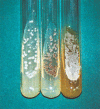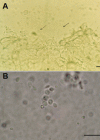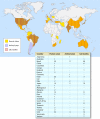Sporothrix schenckii and Sporotrichosis
- PMID: 21976602
- PMCID: PMC3194828
- DOI: 10.1128/CMR.00007-11
Sporothrix schenckii and Sporotrichosis
Abstract
Sporotrichosis, which is caused by the dimorphic fungus Sporothrix schenckii, is currently distributed throughout the world, especially in tropical and subtropical zones. Infection generally occurs by traumatic inoculation of soil, plants, and organic matter contaminated with the fungus. Certain leisure and occupational activities, such as floriculture, agriculture, mining, and wood exploitation, are traditionally associated with the mycosis. Zoonotic transmission has been described in isolated cases or in small outbreaks. Since the end of the 1990s there has been an epidemic of sporotrichosis associated with transmission by cats in Rio de Janeiro, Brazil. More than 2,000 human cases and 3,000 animal cases have been reported. In humans, the lesions are usually restricted to the skin, subcutaneous cellular tissue, and adjacent lymphatic vessels. In cats, the disease can evolve with severe clinical manifestations and frequent systemic involvement. The gold standard for sporotrichosis diagnosis is culture. However, serological, histopathological, and molecular approaches have been recently adopted as auxiliary tools for the diagnosis of this mycotic infection. The first-choice treatment for both humans and cats is itraconazole.
Figures






References
-
- Ahearn D. G., Kaplan W. 1969. Occurrence of Sporotrichum schenckii on a cold-stored meat product. Am. J. Epidemiol. 89:116–124 - PubMed
-
- Albornoz M. B., Villanueva E., Torres E. D. 1984. Application of immunoprecipitation techniques to the diagnosis of cutaneous and extracutaneous forms of sporotrichosis. Mycopathologia 85:177–183 - PubMed
-
- Almeida H. L., Jr, Lettnin C. B., Barbosa J. L., Dias M. C. 2009. Spontaneous resolution of zoonotic sporotrichosis during pregnancy. Rev. Inst. Med. Trop. Sao Paulo 51:237–238 - PubMed
Publication types
MeSH terms
LinkOut - more resources
Full Text Sources
Other Literature Sources
Miscellaneous

